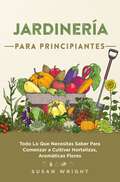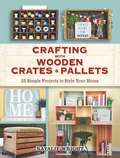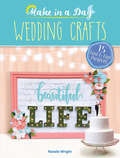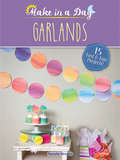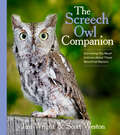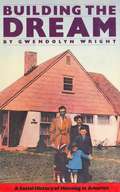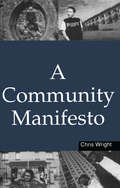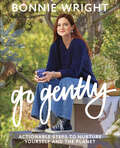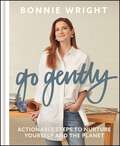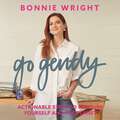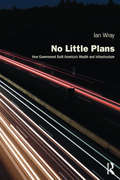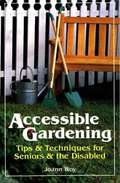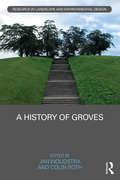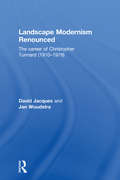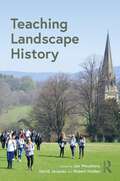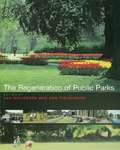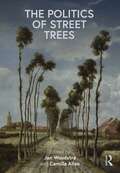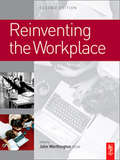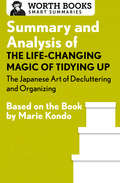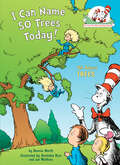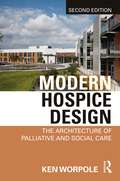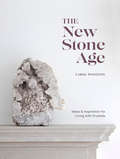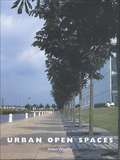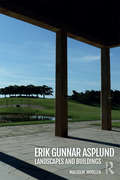- Table View
- List View
Jardinería Para Principiantes: Todo Lo Que Necesitas Saber Para Comenzar a Cultivar Hortalizas, Aromáticas Flores.
by Susan Wright¿Quieres saber como cultivar deliciosas hortalizas, aromáticas y hermosas flores en tu jardín? ¿Quieres hacer en jardín en tu patio pero no sabes cómo comenzar? ¿Sabías que la jardinería puede mejorar diferentes aspectos de tu salud? ¿Tienes planes en tu mente para tu jardín pero no sabes cómo concretarlos? ¿Has estado buscando información que te ayude a entender como cultivar plantas, y cómo prepararte para hacerlo bien? Si esto te resuena, ¡sigue leyendo!
Crafting with Wooden Crates and Pallets: 25 Simple Projects to Style Your Home
by Natalie WrightYou don't have to be a carpenter or a home improvement expert to undertake these twenty-five projects, which combine elements of crafting and woodworking. Step-by-step instructions, accompanied by full-color photos, explain how to build surprisingly simple, attractive, and inexpensive indoor and outdoor furniture. The common denominators in these fun-filled and practical projects are ordinary wooden crates and pallets, which are readily available at craft and home improvement stores, vintage shops, and online. The first project demonstrates how easy it is to build your own crate from scratch. Indoor projects include storage shelves, nightstands, a bookshelf, an upholstered footstool, a benche, a side table, a desk, and storage units. Stepping outside, the projects feature a do-it-yourself children’s lemonade stand and a planter box. Several of the projects are equally functional indoors and out: decorative pieces, a game, a sign, a rolling cart, a toolbox, and other handy and playful items. The ease and simplicity of the projects make them a great way for novices — especially kids — to discover the pleasures and satisfaction of crafting and workworking.
Make in a Day: Wedding Crafts (Make in a Day)
by Natalie WrightIt's one of the most important days of your life. Or it's the wedding of your dear friend or a beloved family member — what can you do to help make it as memorable and personal as possible? Add a graceful and unique touch to the celebration with handcrafted decorations and keepsakes! This practical guide will show you how to quickly and easily create a terrific variety of ornaments: a centerpiece, guest gift, tablescape, and more. You don't need any crafting experience for these easy projects, and best of all, they can be completed in less than a single day.Each book in Dover's Make in a Day series presents 15 projects with illustrated step-by-step instructions. The beginner-friendly projects are ideal for anyone wishing to whip up something simple but special. Supplies are easy to find and are readily available at major craft stores. Other titles in the series include Make in a Day: Modern Wreaths, Make in a Day: Pompom Crafts, Make in a Day: Paper Flowers, Make in a Day: Garlands, and Make in a Day: Centerpieces.
Make in a Day: Garlands (Dover Crafts: Wreaths & Garlands)
by Natalie WrightDecorate your home for any style of occasion with your very own handmade garlands and banners. Fifteen versatile ideas incorporate fabric, felt, ribbons, and other items available at any craft store. The quick and easy projects for adult crafters can be completed in less than a single day and require no previous crafting experience. Each book in Dover's Make in a Day series presents colorful projects with illustrated step-by-step instructions. The beginner-friendly projects are ideal for anyone wishing to whip up something simple but special. They're sure to add a festive touch to any celebration as well as a dash of creative charm to home décor. Other titles in the series include Make in a Day: Modern Wreaths, Make in a Day: Pompom Crafts,Make in a Day: Paper Flowers, and Make in a Day: Centerpieces.
The Screech Owl Companion: Everything You Need to Know about These Beneficial Raptors
by Jim Wright Scott WestonThis must-read for birders features a complete guide to attracting, understanding, and protecting owls. The call of an owl evokes mystery; seeing one in the wild inspires wonder. Of the top ten birds people hope to see, three are owls. Although they may be out of sight, owls are widespread throughout North America—and screech owls are the most likely to make their homes near humans. In this book, experts Jim Wright and Scott Weston show you how to attract them to nest in your yard, year after year.The Screech Owl Companion introduces screech owls, show how to distinguish them from other species, shares fun lore and legend, and provides step-by-step instructions for making your yard screech ready. You&’ll learn how to build a nest box and install a simple nest cam that you can monitor from your cell phone to watch when owls move in, lay eggs, and hatch.
Building The Dream
by Gwendolyn WrightFor Gwendolyn Wright, the houses of America are the diaries of the American people. They create a fascinating chronicle of the way we have lived, and a reflection of every political, economic, or social issue we have been concerned with. Why did plantation owners build uniform cabins for their slaves? Why were all the walls in nineteenth-century tenements painted white? Why did the parlor suddenly disappear from middle-class houses at the turn of the century? How did the federal highway system change the way millions of Americans raised their families?Building the Dream introduces the parade of people, policies, and ideologies that have shaped the course of our daily lives by shaping the rooms we have grown up in. In the row houses of colonial Philadelphia, the luxury apartments of New York City, the prefab houses of Levittown, and the public-housing towers of Chicago, Wright discovers revealing clues to our past and a new way of looking at such contemporary issues as integration, sustainable energy, the needs of the elderly, and how we define "family."
A Community Manifesto
by Chris WrightCivilizations fail when they become trapped in a way of looking at the world that no longer works. For many, globalization is pushing us to the edge of disaster - an onward march of blinkered vision, encouraging passivity, moral blindness and a culture of dependency.A Community Manifesto is an elegantly written polemic offering a new way of looking at our social, cultural and economic realities. Tackling the crucial dimensions of personal responsibility, consensus and community, it shows how we can find a new language through which we can reinvigorate our individual and social lives, developing the resourcefulness we need but which proves so difficult to cultivate. The vision it presents is persuasive and very timely - only by building community can human society evolve and progress.
Go Gently: Actionable Steps to Nurture Yourself and the Planet
by Bonnie WrightGo Gently has descriptive copy which is not yet available from the Publisher.
Go Gently: Actionable Steps to Nurture Yourself and the Planet
by Bonnie WrightAn inspiring and approachable tip-filled guide to changing your habits, living more sustainably, and taking action, by Greenpeace ambassador Bonnie Wright (Ginny Weasley in the Harry Potter movies)Go Gently is a practical guide for sustainability at home that offers simple, tangible steps towards reducing our environmental impact by looking at what we consume and the waste we create, as well as how to take action for environmental change. The title reflects Bonnie's belief that the best way to change our planet and ourselves is through a gentle approach, rather than a judgmental one. This is a book of do's rather than don'ts. Going through every room in her home, Bonnie helps us assess which products are sustainable, and offers alternatives for those that are not. She shares recipes to avoid food waste, homemade self-care products to avoid packaging, small space friendly gardening ideas and a template for creating your own compost system. Finally, there are exercises and meditation prompts to keep you energised, as well as tips on how to get involved in wider community activism.
Go Gently: Actionable Steps to Nurture Yourself and the Planet
by Bonnie WrightAn inspiring and approachable tip-filled guide to changing your habits, living more sustainably, and taking action, by Greenpeace ambassador Bonnie Wright (Ginny Weasley in the Harry Potter movies)Go Gently is a practical guide for sustainability at home that offers simple, tangible steps towards reducing our environmental impact by looking at what we consume and the waste we create, as well as how to take action for environmental change. The title reflects Bonnie's belief that the best way to change our planet and ourselves is through a gentle approach, rather than a judgmental one. This is an audiobook of do's rather than don'ts. Going through every room in her home, Bonnie helps us assess which products are sustainable, and offers alternatives for those that are not. She shares recipes to avoid food waste, homemade self-care products to avoid packaging, small space friendly gardening ideas and a template for creating your own compost system. Finally, there are exercises and meditation prompts to keep you energised, as well as tips on how to get involved in wider community activism.(P) 2022 HarperCollins Publishers
No Little Plans: How Government Built America’s Wealth and Infrastructure (Planning, History and Environment Series)
by Ian WrayIs planning for America anathema to the pursuit of life, liberty and happiness? Is it true, as ideologues like Friedrich Von Hayek, Milton Friedman, and Ayn Rand have claimed, that planning leads to dictatorship, that the state is wholly destructive, and that prosperity is owed entirely to the workings of a free market? To answer these questions Ian Wray’s book goes in search of an America shaped by government, plans and bureaucrats, not by businesses, bankers and shareholders. He demonstrates that government plans did not damage American wealth. On the contrary, they built it, and in the most profound ways. In three parts, the book is an intellectual roller coaster. Part I takes the reader downhill, examining the rise and fall of rational planning, and looks at the converging bands of planning critics, led on the right by the Chicago School of Economics, on the left by the rise of conservation and the ‘counterculture’, and two brilliantly iconoclastic writers – Jane Jacobs and Rachel Carson. In Part II, eight case studies take us from the trans-continental railroads through the national parks, the Federal dams and hydropower schemes, the wartime arsenal of democracy, to the postwar interstate highways, planning for New York, the moon shot and the creation of the internet. These are stories of immense government achievement. Part III looks at what might lie ahead, reflecting on a huge irony: the ideology which underpins the economic and political rise of Asia (by which America now feels so threatened) echoes the pragmatic plans and actions which once secured America’s rise to globalism.
Accessible Gardening: Tips And Techniques For Seniors And The Disabled
by Joann WoyIf advancing age, illness, or accident has made gardening too difficult for you, don't become frustrated. There is an alternative. Accessible Gardening is a book of tips and techniques that will help you to overcome obstacles and return the joy of gardening to your life: recommendations for modifying an existing garden for gardening ease; advice on selecting ergonomic tools and low-maintenance plants; directions for constructing raised-bed planters; instructions for developing manageable watering and pest-control systems; specifications for paths, inclines, and railings; discussion on the psychological and physical benefits of gardening.
A History of Groves (Routledge Research in Landscape and Environmental Design)
by Jan Woudstra Colin RothThe grove, a grouping of trees, intentionally cultivated or found growing wild, has a long diverse history entwined with human settlement, rural practices and the culture and politics of cities. A grove can be a memorial, a place of learning, a site of poetic retreat and philosophy or political encampment, a public park or theatre, a place of hidden pleasures, a symbol of a vanished forest ecology, or a place of gods or other spirits. Yet groves are largely absent from our contemporary vocabulary and rarely included in today’s landscape practice, whether urban or rural. Groves are both literal and metaphorical manifestations, ways of defining spaces and ecologies in our cultural life. Since they can add meaning to urban forms and ecologies and contribute meaningfully to the significance of place, critical examination is long overdue. The editors have taken care to ensure that the text is accessible to the general reader as well as specialists.
Landscape Modernism Renounced: The Career of Christopher Tunnard (1910-1979)
by Jan Woudstra David JacquesBefore the Second World War landscape architect Christopher Tunnard was the first author on Modernism in Landscape in the English language, but later became alarmed by the destructive forces of Post-war reconstruction. Between the 1950s and the 1970s he was in the forefront of the movement to save the city, becoming an acclaimed author sympathetic to preservation. Ironically it was the Modernist ethos that he had so fervently advocated before the war that was the justification for the dismemberment of great cities by officials, engineers and planners. This was not the first time that Tunnard had to re-evaluate his principles, as he had done so in the 1930s in rejecting Arts-and-Crafts in favour of Modernism. This book tracks his changing ideology, by reference to his writings, his colleagues and his work. Christopher Tunnard is one of the most influential figures in Landscape Architecture and his journey is one that still resonates in the discipline today. His leading role in first embracing the tenets of Modernism and then moving away from to embrace a more conservationist approach can be seen in the success and impact on the profession of those with whom he worked and taught.
Teaching Landscape History
by Jan Woudstra David JacquesLandscape history is changing in content and style to address the issues of today. Experienced teachers and authors on the history of gardens and landscapes come together in this new volume to share ideas on the future of teaching history in departments of landscape architecture, archaeology, geography and allied subjects. Design history remains important, but this volume brings to the fore the increasing importance of environmental history, economic history, landscape history, cultural landscapes, environmental justice and decolonisation, ideas of sustainability and climate change amelioration, which may all be useful in serving the needs of a widening range of students in an increasingly complex world. The main themes include: what history should we narrate in the education of landscape architects? how can we recognise counter-narratives and our own bias? how should we engage the students in the history of their chosen profession? how can designers and researchers be persuaded of the relevance of history teaching to theory and practice? and what resources do we need to develop teaching of landscape histories? This book will be of interest to anyone teaching courses on landscape architecture, urban design, horticulture, garden design, architectural history, cultural geography and more.
The Regeneration of Public Parks
by Jan Woudstra Ken FieldhouseThe Urban Parks Programme, financed by the Heritage Lottery Fund, has sparked a new enthusiasm for the regeneration of Britain's parks. This unique reference book gives a valuable overview of all the elements of public park design. It emphasizes our parks' diversity and richness, and offers practical guidance as to their renovation and future care. It is essential reading for all those involved in the design, upkeep and regeneration of public parks.
The Politics of Street Trees
by Jan WoudstraThis book focuses on the politics of street trees and the institutions, actors and processes that govern their planning, planting and maintenance. This is an innovative approach which is particularly important in the context of mounting environmental and societal challenges and reveals a huge amount about the nature of modern life, social change and political conflict. The work first provides different historical perspectives on street trees and politics, celebrating diversity in different cultures. A second section discusses street tree values, policy and management, addressing more contemporary issues of their significance and contribution to our environment, both physically and philosophically. It explores cultural idiosyncrasies and those from the point of view of political economy, particularly challenging the neo-liberal perspectives that continue to dominate political narratives. The final section provides case studies of community engagement, civil action and governance. International case studies bring together contrasting approaches in areas with diverging political directions or intentions, the constraints of laws and the importance of people power. By pursuing an interdisciplinary approach this book produces an information base for academics, practitioners, politicians and activists alike, thus contributing to a fairer political debate that helps to promote more democratic environments that are sustainable, equitable, comfortable and healthier.
Reinventing the Workplace
by John WorthingtonIncorporating a diversity of practices, cultural and organization change, and new building forms, this book provides ideas, inspiration and analysis of the multitude of ways in which an office space can be designed and utilized. Updated to cope with technological advances, as well as including a new series of case studies on recent Australian, North American and Scandinavian experiences, the contributors draw on a wealth and variety of professional experience to present the best and most innovative solutions for today's office - and tomorrow's workplace.
Summary and Analysis of The Life-Changing Magic of Tidying Up: Based on the Book by Marie Kondo (Smart Summaries)
by Worth BooksSo much to read, so little time? Get a brief overview of the Japanese KonMari method of organizing and take control of your life. Japanese cleaning consultant and New York Times–bestselling author Marie Kondo is known for the revolutionary method of organization detailed in her book The Life-Changing Magic of Tidying Up, which has helped millions create and keep tidy homes. With chapter-by-chapter breakdowns, this summary explains the key points of her book, including: How a calm, comfortable home can ease your mindWhy a &“little-by-little&” approach doesn&’t workHow to identify items that &“spark joy&” and dispose of those that don&’tHow to declutter your home by category Complete with historical context, important quotes, fascinating trivia, a glossary of terms, and other features, this summary and analysis of The Life-Changing Magic of Tidying Up is intended to complement your reading experience and bring you closer to a great work of nonfiction.
I Can Name 50 Trees Today!: All About Trees (Cat in the Hat's Learning Library)
by Bonnie WorthGet ready to grow and learn all about trees with the Cat in the Hat--a perfect gift for nature lovers on Earth Day and every day! The Cat in the Hat's Learning Library is a nonfiction picture book series that introduces beginning readers ages 5-8 to important basic concepts. The Cat in the Hat and friends explore some of the world&’s most amazing trees, teaching beginning readers how to identify different species from the shape of their crowns, leaves, lobes, seeds, bark, and fruit. Kids will learn about many trees common to North America. Featuring beloved characters from Dr. Seuss's The Cat in the Hat, the Learning Library are unjacketed hardcover picture books that explore a range of nonfiction topics about the world we live in and include an index, glossary, and suggestions for further reading.
Modern Hospice Design: The Architecture of Palliative and Social Care
by Ken WorpoleThe new edition of this acclaimed book comprehensively updates its timely advocacy of the need for good quality palliative care, today more necessary than ever. Rooted in the social history of the care of the elderly and terminally ill, Modern Hospice Design: The Architecture of Palliative and Social Care takes cognisance of the new conditions of social care in the 21st century, principally in the UK, Europe and North America. It does so with regard to the development of new building types, but also in response to new philosophies of palliative care and the status of the elderly and the dying. Benefitting from a clearer methodological approach and conceptual framework, the expanded book allows a broad section of readers to navigate the text more easily. At its core is a public discussion of a philosophy of design for providing care for the elderly and the vulnerable, taking the importance of architectural aesthetics, the use of quality materials, the porousness of design to the wider world, and the integration of indoor and outdoor spaces as part of the overall care environment. In doing so it advocates care settings that, in the words of Maggie Jencks whose life and ideas inspired the Maggie’s Centres, ‘rise to the occasion’. Including new chapters and new in-depth case studies, complete will full colour illustrations, this book is for architects and interior designers and their students, healthcare professionals, social care providers, estate and facility managers, hospital administrators and Healthcare Trust Boards.
Landscape Architecture Documentation Standards: Principles, Guidelines And Best Practices
by Design WorkshopAchieve better execution with the documentation standards behind an industry-leading firm Construction Documentation Standards and Best Practices for Landscape Architectural Design offers guidelines, methods, and techniques for creating more robust project documents. Developed and authored by one of the world's leading landscape architectural firms, this material has been field tested by Design Workshop's ten offices and 150 designers to ensure completeness, practicality, and effectiveness. The book provides an overview of the entire design and construction process in the context of actual documentation, with best practice standards for design document content, format, and graphics. Readers learn how to apply these practices to serve the specific needs of different projects, gaining a comprehensive understanding of how complete documentation better serves the project as a whole. Good documentation leads to good execution, which leads to better performance from the perspectives of durability, safety, and user enjoyment. This book presents a set of standards that serve as a roadmap of the design process, helping designers provide the complete documentation that the most highly executed projects require. Discover how documentation ties into project performance Learn the best practices for documenting every stage of the process Study actual project documents serving various project needs Gain documentation insights from one of the world's top firms Design Workshop has been an industry leader since 1969, with projects ranging from resorts, to wildlife refuges, to county master plans. The value of their insight is proven by the continued high performance of their projects across the U. S. and beyond, and this book contains the standards, techniques, and actual documentation behind this success. Better outcomes require better execution, which starts with the documentation standards presented in Construction Documentation Standards and Best Practices for Landscape Architectural Design.
The New Stone Age: Ideas and Inspiration for Living with Crystals
by Carol WooltonA fashion-forward guide to living well with crystals from the jewelry editor of British Vogue—including guidance and advice from designers, jewelers, and celebrity crystal fans.The New Stone Age guides you through fifteen different types of stones, categorized by color, and teaches you how to stylishly incorporate them into your wardrobe, home, and beyond. Assigning each crystal to a particular ailment of the modern age, whether it&’s self-doubt, travel anxiety, or restlessness, Carol Woolton explains how a simple crystal worn around your neck, tossed in your purse, or sitting next to your computer can help inspire you to make positive changes in your life. Woolton traces the history of crystals, showing how the same quartz that was used as a form of protection in the handles of Egyptian daggers can also be hung near a bedside to help with burnout. Filled with insights, facts, and real-life stories from people who attribute dramatic personal improvements to their crystals, The New Stone Age is a fun and informative idea book for crystal lovers everywhere.
Urban Open Spaces
by Helen WoolleyThere is enormous interest in urban design and the regeneration of our urban areas, but current thinking often concentrates on the built form, forgetting the important role that open spaces play. Urban Open Spaces brings together extensive research and practical experience to prove the opportunities and benefits of different types of open space to society and individuals. Focusing on the importance of open spaces in daily urban life, the book is divided into three sections. The first section describes the social, health, environmental and economic benefits and opportunities that open spaces can provide. The second section discusses the different types of urban open spaces that individuals or communities might use on a daily basis: from private gardens to commercial squares and waterway corridors. The final section provides best practice case-studies demonstrating urban spaces being incorporated in new developments and community initiatives. This is the first book to bring together a variety of evidence from different disciplines to outline the benefits and opportunities of urban open spaces in an accessible way. Not just for students and practitioners, this book will be of value for anyone interested in the design, development, regeneration, funding and use of open spaces in urban areas.
Erik Gunnar Asplund: Landscapes and Buildings
by Malcolm WoollenTaking an interdisciplinary approach, weaving together art, philosophy, history, and literature, this book investigates the landscapes and buildings of Swedish architect Erik Gunnar Asplund. Through critical essays and beautiful illustrations focusing on four projects, the Woodland Cemetery, the Stockholm Public Library, the Stockholm Exhibition and Asplund’s own house at Stennäs, it addresses the topic of buildings accompanied by landscapes. It proposes that themes related to landscape are central to Asplund’s distinctive work, with these particular sites forming a collection that documents an evolution in his design thinking from 1915 to 1940. The architect himself wrote comparatively little about his design intentions. However, through close reading and analysis of the selected projects as landscapes with architecture, author Malcolm Woollen argues that reflections of the history of Swedish landscape architecture and the intellectual climate in the late nineteenth and early twentieth centuries are evident in his work and help to explain the architect’s intentions. This book is a must-have for academics, advanced students and researchers in landscape architecture and design who are interested in Nordic Classicism and the works of Erik Gunnar Asplund.
